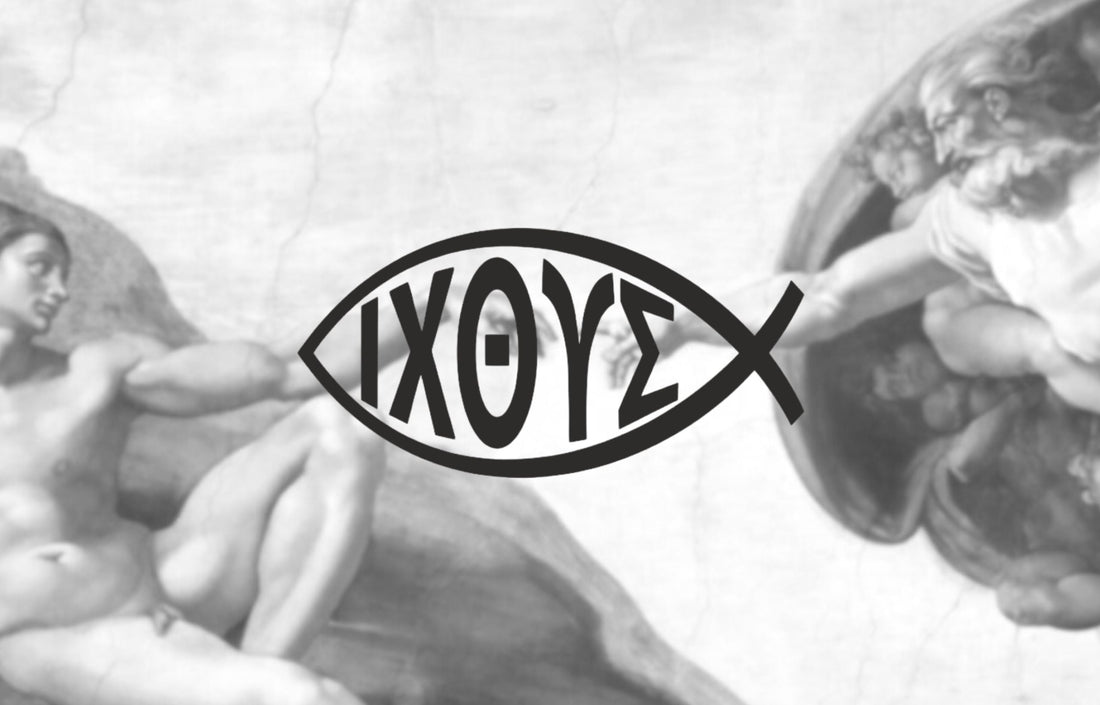The Ichthys, or Jesus fish, is one of Christianity’s oldest symbols—originally used by believers to secretly identify one another during times of Roman persecution. This simple design, formed by two intersecting arcs creating a fish outline, holds profound theological meaning.
The Greek word ἰχθύς (Ichthys) is an acrostic for Ἰησοῦς Χριστός, Θεοῦ Υἱός, Σωτήρ—“Jesus Christ, God’s Son, Savior.” It served as a discreet code to express core Christian beliefs when open worship could be deadly.
Table of content
Origins and Meaning of the Ichthys
The Acrostic Explained

The Greek word ἰχθύς (ichthys), meaning “fish,” became an early Christian acronym for:
- Ἰησοῦς (Iēsous) – Jesus
- Χριστός (Christos) – Christ
- Θεοῦ (Theou) – of God
- Υἱός (Huios) – Son
- Σωτήρ (Sōtēr) – Savior
This concise formula captured essential Christian beliefs, enabling followers to express their faith covertly during times of persecution during the 1st to 4th centuries. Clement of Alexandria, writing around 200 AD, highlighted this symbolic use in his work Paedagogus (c. 198–203 AD).
Fish in Scripture and Sacrament
The fish image draws on biblical scenes: Jesus feeding multitudes with fish, calling disciples to be “fishers of men,” and baptismal metaphors linking Christians to “living in water.” Early theologians like Tertullian connected the symbol to baptism, emphasizing rebirth and salvation.
Key Fish References in the Bible:
- Jonah 1:17 – The "great fish" prefiguring Christ’s resurrection.
- Matthew 4:19 – "I will make you fishers of men."
- Luke 24:42-43 – Jesus eats fish post-resurrection (proving His bodily resurrection).
- Tobit 6:1-9 (Deuterocanonical) – Fish as a tool of healing (for Catholic/Orthodox audiences).
Early Christian Use in Times of Persecution
The ichthys often appeared alongside Jonah’s story—a symbol of Jesus’ death and resurrection. It joined other secret Christian symbols like the staurogram (crucified Christ) and the anchor (hope), forming a rich visual code for believers under persecution.

A Symbol of Survival
During Christianity’s dangerous early centuries (1st to early 4th), Roman emperors like Nero and Decius launched brutal persecutions. Openly declaring faith in Jesus Christ could mean imprisonment, torture, or death.
In response, Christians used the ichthys as a secret symbol. Its simple fish shape was easy to sketch or erase quickly, allowing believers to identify each other discreetly. For example, one person might draw a curved arc in the dirt, and a fellow Christian would complete the fish—signaling shared faith without raising suspicion.

Secret Signs in Sacred Spaces
The ichthys also marked locations of underground Christian gatherings, especially in cities like Ephesus. These covert meetings centered on baptism and Eucharist rites, vital spiritual ceremonies held in hidden places. The fish symbol functioned like a coded map, guiding believers safely to these gatherings.
Faith in the Catacombs
In Rome’s catacombs—like Saint Sebastian, Priscilla, and Domitilla—ichthys symbols appear alongside anchors and doves. Etched near tombs, the fish signified faith in resurrection and eternal life, offering comfort and identity to Christians who could not worship openly.
Theological Interpretations
Clement of Alexandria and the Ichthys Acrostic

The earliest solid evidence of the ichthys as a Christian acrostic comes from Saint Clement of Alexandria around 200 AD. In Paedagogus (Book 3, Chapter 11), he explains how the Greek word ἰχθύς stands for Iēsous Christos, Theou Huios, Sōtēr—“Jesus Christ, Son of God, Savior.” This clever shorthand captured the heart of Christian belief, making the fish both a devotional symbol and a compact statement of faith.
Tertullian’s Baptismal Metaphor
In On Baptism (Chapter 1), Tertullian adds another layer by comparing Christians to fish “born in water.” This links the ichthys directly to baptism, emphasizing spiritual rebirth. So, the fish isn’t just a secret handshake—it’s a symbol of salvation and new life.
Origen’s Exegesis on Fish Imagery
Origen, a major 3rd-century theologian, saw fish symbolism as a call to evangelism. In his Commentary on Matthew (10:10), he interprets Jesus’ command to be “fishers of men” as a metaphor for spreading the Gospel. Through Origen’s eyes, the ichthys represents the mission to reel others into faith.
Augustine and Basil the Great

Church Fathers like Augustine and Basil the Great gave theological depth to the fish through allegorical readings. In City of God, Augustine noted how the acrostic "ΙΧΘΥΣ" summarizes the gospel, and in his Hexaemeron, Basil reflects on the properties of fish—like their scales—as metaphors for spiritual armor.
Greco-Roman Parallels and Pagan Reappropriation
Fish Symbolism in Ancient Religions
Long before Christianity, fish were widely regarded as symbols of life, abundance, and mystery within various pagan belief systems. These motifs held particular significance in Greco-Roman and Near Eastern religious contexts. One notable example is the Syrian goddess Atargatis, often depicted as a mermaid or fish, was worshipped as a life-giver and protector of waters.

Meanwhile, in Egyptian mythology, the Nile’s fish were seen as symbols of abundance and rebirth, tied to the cyclical flooding that sustained civilization.
Even astrology played a role: The Pisces constellation, associated with Venus and Cupid in Roman myth, was sometimes interpreted as two fish bound together—a possible precursor to the Ichthys’ intertwined arcs.
Christian Reappropriation of Common Symbols
Early Christians didn’t invent the fish symbol from scratch. Instead, they repurposed preexisting and widely recognized iconographic motifs to convey new theological meanings.
As historian Everett Ferguson (Backgrounds of Early Christianity, 2003) highlights in Backgrounds of Early Christianity (2003), this strategy helped Christians to navigate their cultural environment—both integrating into and subtly subverting prevailing Greco-Roman norms.

By adopting a common symbol, believers could express faith in ways that resonated visually but eluded persecution. This reappropriation also linked Christian identity with broader themes of life, renewal, and salvation, making the ichthys an effective bridge between older religious frameworks and emerging Christian doctrine.
Artifacts and Archaeological Evidence
Ichthys in the National Roman Museum

The National Roman Museum holds several artifacts featuring the ichthys, illustrating its early use as a Christian symbol. These items include frescoes, inscriptions, and jewelry dating mainly from the 2nd to 4th centuries. Their presence in such a prestigious collection highlights how the ichthys transitioned from a secret sign to an established emblem of faith.
Artistic Trends from the 2nd to 4th Centuries
Scholar Lee Ann Snyder documents in Ante Pacem (2003) how the ichthys gained prominence in Christian art during this period. The symbol appears in house churches, catacombs, and on sarcophagi, often accompanied by other Christian imagery. This era marks the blossoming of Christian iconography as believers became more confident in expressing their faith visually, even before Constantine’s legalization of Christianity.

Eucharistic Symbolism: Fish and Bread
In the Catacomb of Callixtus, art depicts fish alongside loaves of bread—a clear reference to the Eucharist and Jesus’ miracle of feeding the 5,000. As noted by Finney in The Invisible God (1994), this “fish and bread” motif emphasizes both sustenance and salvation. It anchors the ichthys within the liturgical life of the early Church, linking the symbol to communal worship and divine provision.
The Ichthys in Modern and Global Contexts
Today, the ichthys remains a widely recognized symbol of Christian faith in the U.S., with about 60% of American Christians identifying it, though only 30% know the full acrostic meaning (Pew Research, 2010). It’s commonly featured on car decals, church logos, Christian apparel, and jewelry—offering believers a subtle yet meaningful way to express their faith daily.

Controversies and Modern Debates
In recent decades, the ichthys has sparked both reverent revival and playful parody. One of the most well-known is the "Darwin fish"—a version with legs and "Darwin" inside—poking fun at creationist views and highlighting the faith-science tension. Responses range from counter-symbols to essays defending the compatibility of evolution and Christianity.
Usage Varies Across Denominations
Protestants often embrace it as a unifying emblem, while Catholics and Orthodox Christians typically reserve it for liturgical or catechetical contexts. Its meaning thus shifts depending on where—and how—it’s used.
Global Perspectives
In persecuted regions like the Middle East, North Africa, and China, the ichthys has resurfaced as a discreet sign of faith—etched on walls, worn as jewelry, or embedded in art. Here, it reclaims its ancient role as a secret symbol of solidarity.
Liturgical and Sacramental Use
Baptismal imagery still uses the fish. Many modern fonts include fish motifs symbolizing rebirth and discipleship, echoing the first apostles—fishermen called by Christ. This keeps the symbol rooted in Christian initiation and community.
Conclusion and Reflection
The ichthys remains a profound emblem of Christian faith. This Christian symbol connects believers not only to early Christians’ courage but also to an enduring tradition of hope and witness. Whether on a car bumper or in theological discourse, the Jesus fish continues to invite believers into a rich spiritual heritage.














